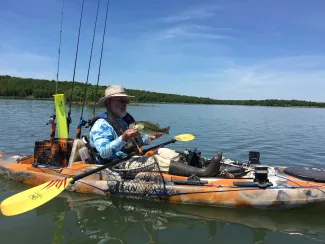Getting on the water doesn’t have to be expensive, can get you some exercise, and most importantly, can be a very effective way to catch fish without a traditional fishing boat. More anglers are finding that kayak fishing is not only inexpensive and fun but is sometimes even more effective than those high-dollar fishing rigs at putting a big fish on the end of your line.

The first step is deciding if you are mentally suited for kayaking. Do you love to hear that big outboard scream and feel the rush of a boat jumping up and accelerating across the lake? Or is stopping for a few minutes to watch a mother grebe taking her new offspring for a ride more your style? Kayaking is best enjoyed by those who aren’t in a great hurry.
Are you comfortable when wet? In a kayak, you are literally sitting at water level, and getting wet is part of the experience.
The Inuit people of the North are generally given credit at being the developers of the first fishing/hunting kayaks more than 4,000 years ago. Despite their small size, kayaks were crucial in helping the Inuit master the mighty ocean and ice packs with craft created from nothing more than skins stretched over a frame of bone or driftwood. Things have changed a bit since then.
Jump forward to the late 1960s, when a southern California surfer and diver, Tim Niemier, was generally credited with creating the original sit-on-top. He carved out seats and tank wells in old fiberglass surfboards and sold them right on the beach or along the highway. His business caught fire, and he was soon mass-producing his sit-on-top.
The real breakthrough was the development of the rotomolding process, which resulted in the modern sit-on-top, plastic kayak. The market then started booming in the early 1970s. Some 50 years later, fishing in kayaks is becoming common.
A wide range of kayaks are available to anglers. An Internet search will quickly provide the prospective kayak buyer an almost bewildering assortment of boats, even kayaks you can pedal instead of paddle. Realize that there is no “one best kayak,” but there are probably a few well-suited to you and your needs.
Long, narrow kayaks are faster and less stable (easier to flip over) than short, wide kayaks. If you primarily fish small reservoirs or farm ponds, the need for speed really isn’t a factor. The longer, narrower boats cover more distance faster and also paddle (or peddle) easier into the wind. Many kayaks in the 12- to 14-foot range track well and are still plenty stable.
Also, pay attention to the kayak’s weight capacity. The closer the weight of you and your gear is to the kayak’s weight capacity, the lower the boat will ride on the water and the less water-worthy it will be.
Once you’ve narrowed your search, go for a test-paddle. A used-kayak seller should let you take it for a test float, if for no other reason than to assure you the boat doesn’t leak. Just make sure it is comfortable, paddles well, and that it’s watertight.
Renting a kayak is also an option to test various types. Take your time, do some research, and get a kayak that works for you (after you have paddled it).
Every kayak needs a paddle, and they come in a number of styles and lengths. Aluminum, fiberglass, and carbon are the most common paddle shaft materials. Aluminum paddles are the heaviest (and cheapest), and carbon paddles are the lightest and priciest. The lighter the paddle, the longer you’ll be able to use it before you get tired.
And every kayaker needs a comfortable Personal Flotation Device. Wearing one at all times is a must for any responsible paddler. The possibility that you will wind up in the water is much greater in a kayak than in a boat.
Learn how to get back in your kayak should you fall out by going out and practicing re-entry in shallow and deep water, and have someone else there in another boat to help you if you can’t get back on your kayak.
Finally, it’s time to make a fishing craft out of it. The amount and type of customizing you do is up to you. But rather than getting carried away with every gadget on the market, let your fishing style dictate how to rig your kayak. Many accessories can be obtained inexpensively or even made from unused household items. Old cell phone cards make great paddle and rod keepers. Ice chests transform into floating tackle boxes or bait tanks. A plastic milk bottle can hold extra gear and tackle. Adding a few pieces of PVC to the right spot on your kayak provides rod holders.
With some creativity and Internet research, there is no shortage of resources available to answer questions and solve rigging issues you might encounter.
Kayaks allow you to get on the water for cheap. You just might be surprised at how much fun you can have spending so little money. And they make great fishing platforms. What you sacrifice in speeding all over the lake is more than offset by the kayak’s greatest attribute: stealth. No 20-foot boat sneaks up to a sunken brush pile, roadbed, or shallow rocky point like a well-paddled kayak!